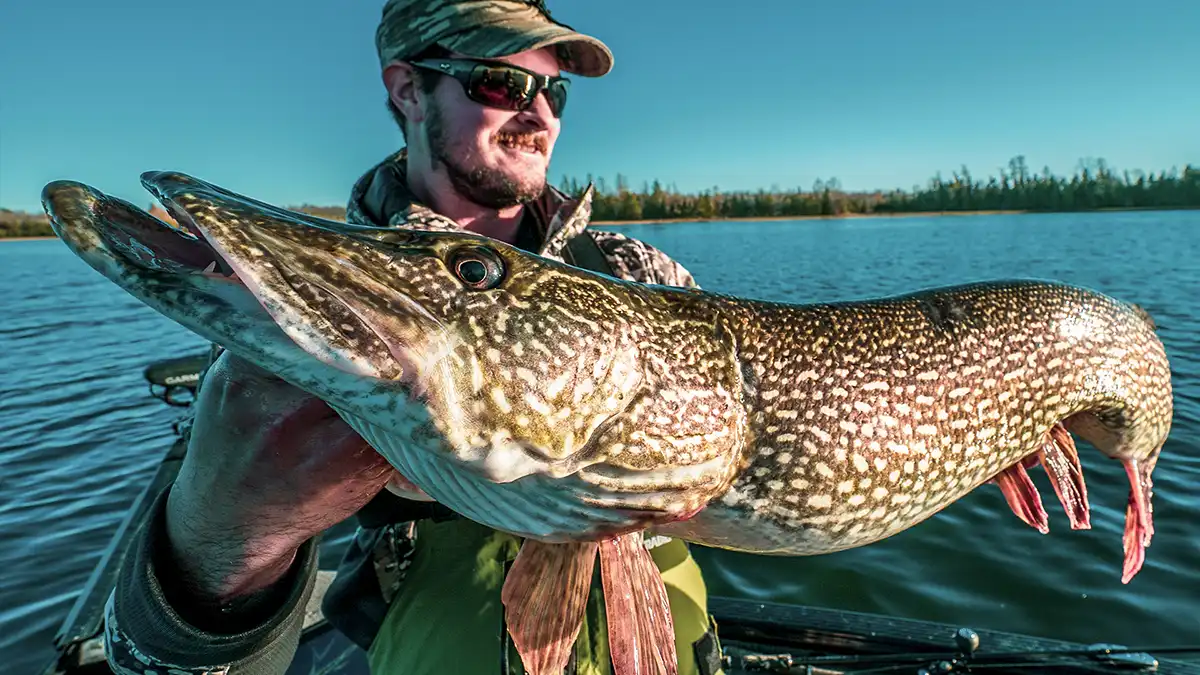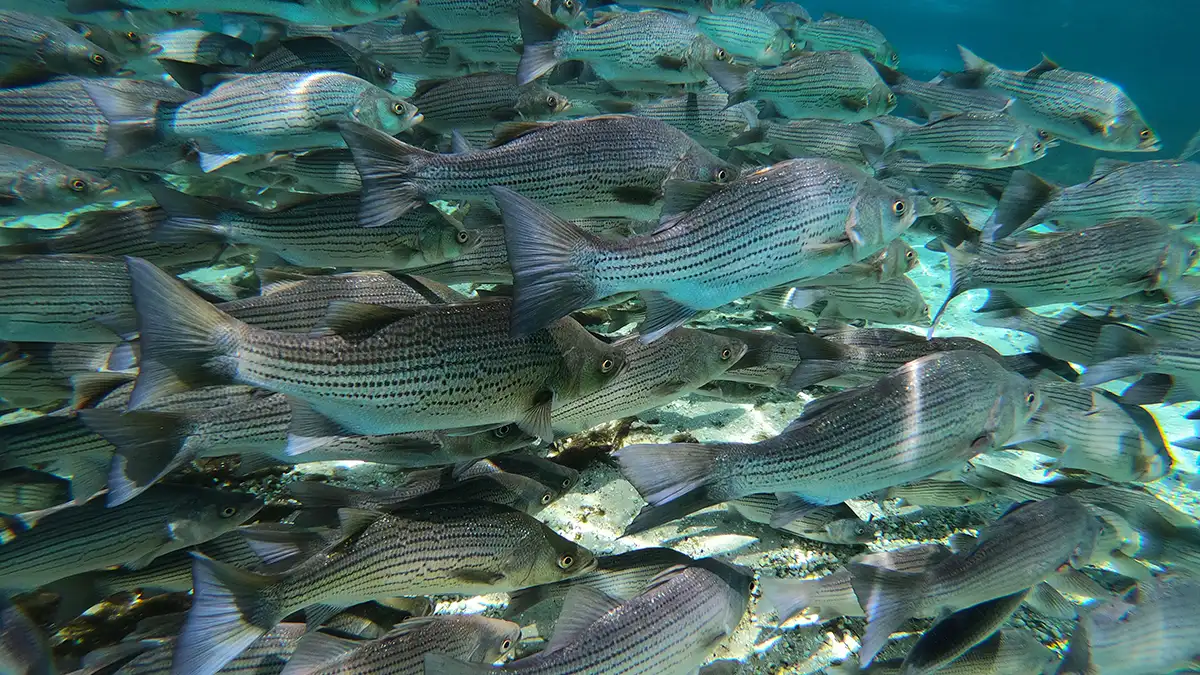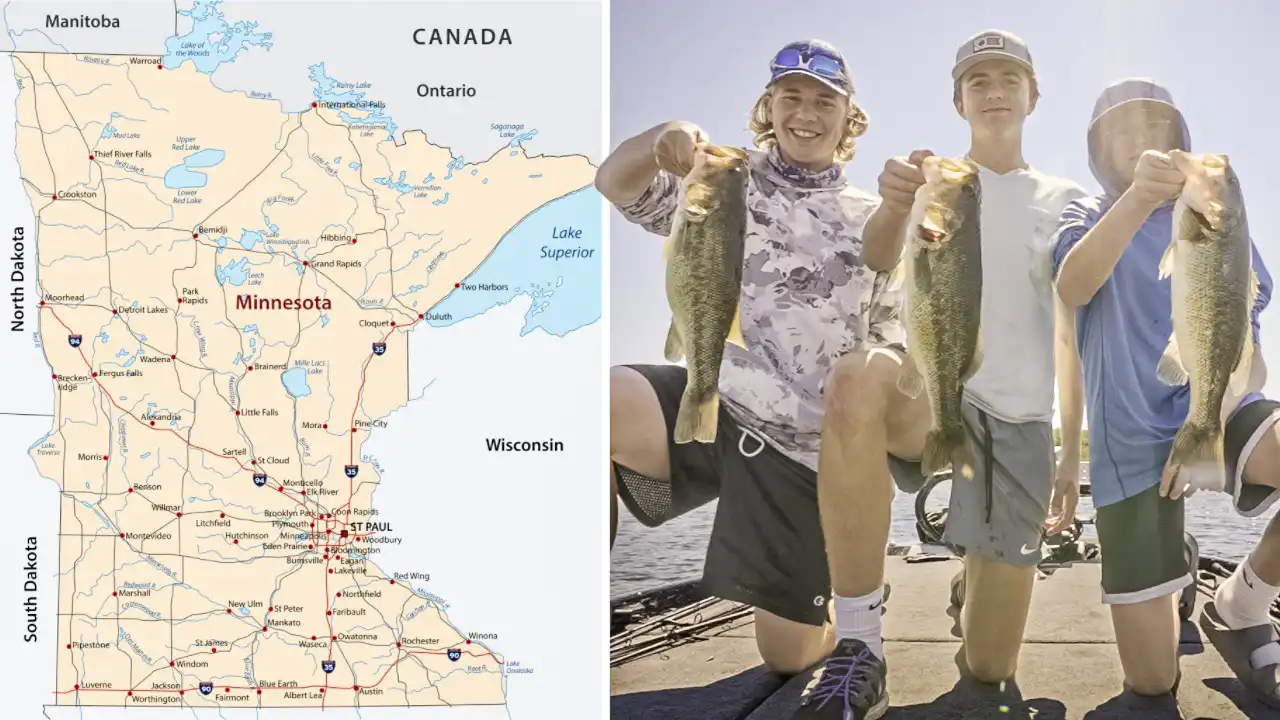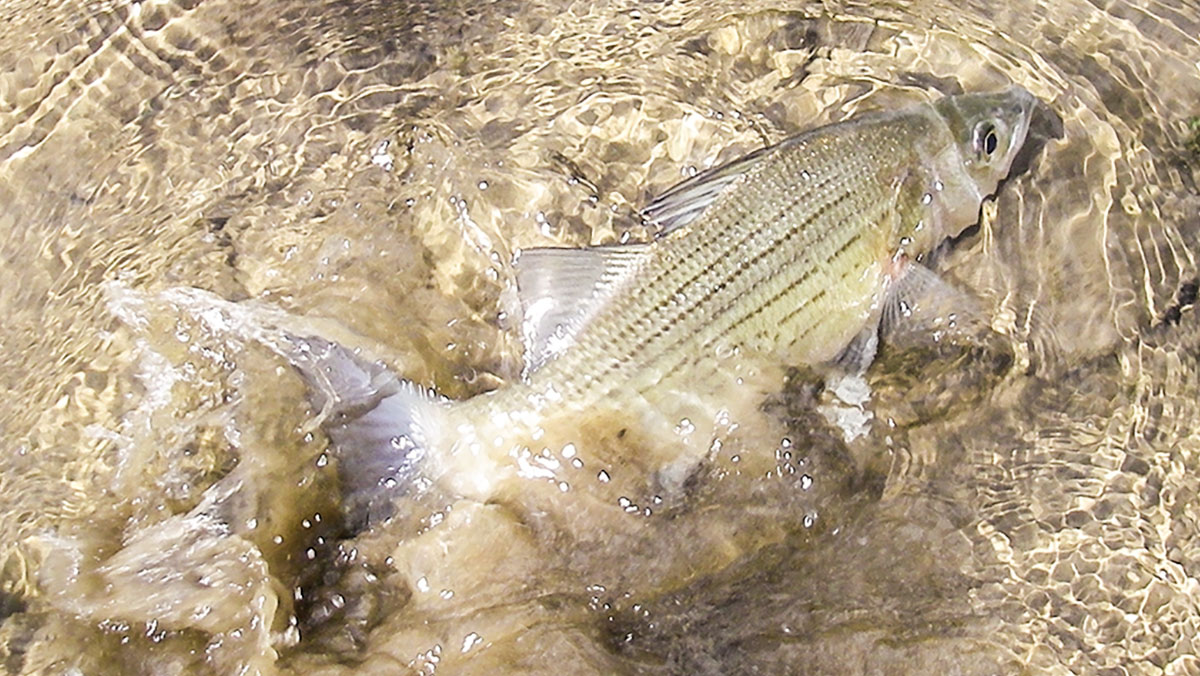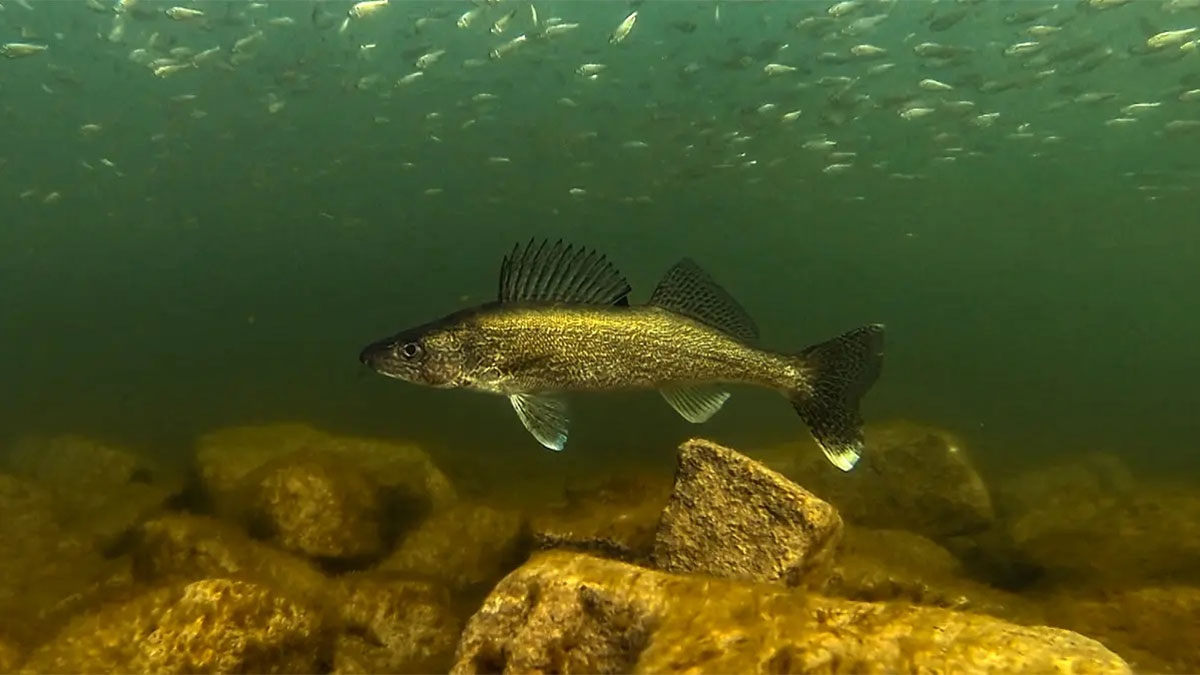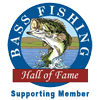Northern Pike are a cool water toothy torpedo shaped fish that either delights or frustrates anglers. They can have extraordinarily complex markings that change based on age. They also hybridize with both muskellunge and pickerel species as well as other pike species across the world. If any of this is news to you, or you just love pike, we have compiled all you need to know about northern pike in this species profile.
Northern Pike History
Northern Pike (Esox lucius) belong to the Esocidae family, which includes pickerel, pike, muskellunge, and mud minnows. Around the world pike species include northern pike, southern pike, amur pike, and the recently described aquitanian pike. In North America northern pike are able to cross with muskellunge resulting in a hybrid known as a Tiger Musky. They are also able to hybridize with pickerel species on rare occasions.
Northern pike were first described by Carl Linnaeus, a Swedish scientist. Linnaeus described the northern pike in “System of Nature Through the Three Kingdoms of Nature, According to Classes, Orders, Genera, and Species, with Characters, Differences, Synonyms, Places.” The name Esox lucius doesn’t have a well defined origin. Exos is believed to be a latin form of the Greek word ixos which means “a fish”. The name lucius does not have a specific origin, it first appeared in 1850 as lucioides in an article by Aggasiz and Girard and was shortened to lucius in 1876 by Jordan. Hegemann in 1964 gave the explanation of the latin meaning of lucius as “giving light” as the possible root describing the light green coloration of the body.
Northern Pike have several nicknames, such as Canada pike, shovelnose pike, grass pike, slime pickerel, snot rockets, snake pickerel, hammer handles, jack, and jackfish.
Northern Pike Location
Northern pike are the only members of the Escoidae family with a natural large geographic range. They can be found primarily in cold water fisheries throughout the northern hemisphere of North America, Europe, and Asia. Historically northern pike in North America were found as far north as the arctic regions of Alaska. They stretched throughout Canada and south into the upper Mississippi River basin in the US as far as Missouri. The historic western most U.S. boundary in the lower 48 states was Montana, Wyoming, and Nebraska. The eastern reaches of the population was throughout the Great Lakes and as far as Maine. In Europe and Asia they were found in Finland, France, Germany, Greece, Hungary, Italy, Poland, Russia, Sweden, Turkey, the United Kingdom, Ukraine, and more.
Through both an increase in popularity as a sportfish and in an attempt to control common carp or gizzard shad populations the current range of northern pike has greatly expanded. Intentional and unintentional stockings of northern pike in the US have been successful as far south as central Texas, west into California, and east into North Carolina. Due to their inability to tolerate and successfully spawn in warmer climates, the northern pike was unsuccessful in becoming established in warm water tropical areas.
Stocking of exotic amur pike Esox reichertii were purposely attempted by the Pennsylvania Fish Commision in the late 1960s and early 1970s. The last amur pike were spawned in 1971 and the Commission’s entire brood stock was lost in 1976. The amur pike is also known as blackspotted pike and is native only to the Amur river drainage in China. At this time the Pennsylvania population is considered to be non-existent with the last observation occurring in 1991.
To see the extent of the native and introduced ranges of northern pike throughout North America, we have created this interactive map.

Northern Pike Identification
Due to their similar characteristics, most notably their body shape and toothy mouth, the northern pike can be confused with the southern pike in Europe and young muskellunge or large pickerels throughout North America.
One of the key characteristics of the northern pike is its long “duck-bill” snout and horizontal mouth. The mouth contains dozens of canine teeth that grow up to 1 inch in length. When the mouth is closed the lower jaw protrudes beyond the upper, and the rear of the upper jaw reaches to the mid part of the eye. Below the jaw will be submandibular pores. Northern pike will typically have 5 pores on each side, but can sometimes have 4 or 6. In comparison musky will have 6 to 9 submandibular pores and pickerel will have 4 to 5 on each side.
The cheek of the fish, located directly behind the eye, will be covered in scales. The operculum of the northern pike is partially covered in scales with the upper section being scaled and the lower section scaleless. In comparison the cheek and lower section of the muskellunge operculum will have no scales and chain pickerel will have scales on both the cheek and operculum.
Below the operculum there will be a branchiostegal membrane that creates countable folds or rays. Northern pike will have 11 to 16 branchiostegal rays on each side. In comparison musky will have 16 to 19, chain pickerel will have 14 to 17, redfin pickerel will have 5 to 8, and grass pickerel will have 4 to 8.
The northern pike body is elongated and fairly flattened or tubular. Their body depth is typically less than ⅓ of their length. The majority of the body is olive to brown in coloration with a light yellow to white stomach and lower jaw. Young northern pike will express different patterns from adults. The juveniles will have distinct light colored broken slanted bars on their sides. As they age slanted bars will become less prominent and a spotted pattern will begin to develop. The side spotting will be small, light colored, and round to oblong. These spots will typically dull as fish increase in size. As juveniles age to adults dark spots on the fins will also begin to appear. The northern pike will have a “teardrop” marking found just below the eye along the suborbital line and will become more transparent on adult fish.
The northern pike’s caudal fin will be forked with rounded edges. The single rounded dorsal fin sits directly in front of the caudal fin and is similar in size and shape to the anal fin. Both the dorsal and anal fins will consist of 13 to 17 rays. The pelvic fins will be slightly rounded and have 9 to 10 rays. Pectoral fins will be slightly larger than the pelvic fins and have 13 to 16. Lateral line scale counts average between 120 to 135 scales but range from 105 to 148 scales. The location of the dorsal, anal, and caudal fin in conjunction with the elongated, slender body, is built for quick bursts of speed to capture prey but will have a more difficult time making quick, sharp turns compared to other species of fish.

Northern Pike Spawning
Northern pike spawning season usually begins when water temperatures reach 40F to 45F between and ending before water temperatures reach 60F. This is before both pickerel and muskellunge, which gives northern pike fry a competitive advantage. During spawning, pike can become aggressive towards each other and other fish that dare to come too close. If you were to look closely, you would see scares on the sides of the pike and even damage to their scales that likely occurred during spawning activity.
Depending on the size of the water body, spawning can occur in various habitats. Pike will begin to migrate into marsh areas seeking flooded emergent vegetation, sunken brush, thick reeds, or any dense habitat. There is some evidence of individuals spawning in similar locations each year. Male pike will reach the spawning grounds a week or more before the females. Smaller females will pair with one male, while larger females can pair with up to three males. They will swim eye to eye releasing eggs and fertilizing them as they swim through vegetation. The spawning attempt will last for a few seconds to minutes with 5 to 60 eggs being released. Females will continue to spawn for 5 to 10 days, laying 8,000 to 12,000 eggs per pound on average. Males will stay in spawning areas for two to four additional weeks attempting to spawn multiple times. Females can abandon spawning if water temperatures increase and will reabsorb their eggs. Females carry eggs throughout the year resulting in various stages of egg development within their ovaries. Egg mass can make up 15 to 20% of the female’s body weight.
Northern pike offer no paternal care or nest building. The eggs slowly sink, forming a cluster that attach themselves to any nearby dense habitat. Eggs are yellow in color, .07 to .1 inch in diameter, and almost immediately become adhesive once fertilized. They hatch slowly based on water temperature. Average hatching time at 50 F is 10 days, with eggs hatching slower in cooler and faster in warmer temperatures. Optimal egg hatching range is between 48F and 58F. Egg hatching success and survival is greatly dependent on temperature with the best survival at 50F and rapidly decreasing above 60F to almost zero.
Northern Pike Size and Lifespan
At hatching, northern pike fry are .3 to .4 inches in length and position themselves immediately in a vertical position and attach to vegetation with a mucus gland. Over the next several days they remain attached and survive off the yolk sack while their bodies develop. Their mouth and fins form over 6 to 7 days. After 8 to 10 days their swim bladder should be fully formed and they will swim up filling it with air. At this time the juvenile pike do not yet look like pike but can swim horizontally and begin to feed. Between day 10 and 15 the teeth of the northern pike begin to develop. When the mouth forms, the young pike will start consuming zooplankton, eating larger prey as they age. The fry will stay in the same areas as they were spawned until they are about 2 to 3 inches long, then move into deeper water.
Northern pike will grow from hatching size of .3 inches to 3 inches within the first four months of their lives. Growth is highly dependent on water temperature and competition. In northern latitudes growth is slower with the pike reaching 6 inches in year 1, doubling to 12 inches in year 2, increasing by 4 inches in years 3, 4, and 5, and around 2 inches of growth each subsequent year. In the southern areas northern pike can grow to 10 inches in year 1, 16 inches in year 2, 20 inches in year 3, and 2 years each subsequent year. The type of fishery also strongly affects growth with shallow marsh like fisheries having better growth rates then river and stream systems. Male pikes grow slightly faster and mature 1 year earlier than females and at 10 inches in length.
As with most fish, northern pike lifespan is also greatly tied to fishery type and temperature. Fish living in cooler water can live in excess of 20 years with the oldest recorded being 30 years old. Southern, warmer fisheries see northern pike living to 10 years.
Northern Pike Habitat
Northern pike prefer clearer slow moving water in ponds, lakes, or streams.. Pike mostly utilize shallow, vegetated areas where annual weed beds can be used to lie and wait on prey. They can be highly territorial and will consume other pike to prevent them from entering their home range. Their feces will contain alarm pheromones that warn other pike of their presence. Because of this young adult pike will utilize deep water vegetation and avoid the shallow vegetation preferred by large adults.
Pike will utilize deep water in the heat of summer to seek cooler, more oxygen rich water as well as over winter to find warmer water, especially if the waterbody freezes over.

Northern Pike Diet
The adult northern pike diet mainly consists of fish such as yellow perch, chubs, suckers, walleye, bass, etc. However, they also feed on almost any other creature in the water that is a third or less of their body length. Crawfish, frogs, mice, small birds, snakes, and even other pike are all consumed by northerns. Because of diet similarity to other predator fish such as bass and muskellunge, over-competitive environments can result in stunted growth between competing fishes.
Pike are ambush predators that feed mainly by laying in vegetation and allowing prey to get close before lunging at it. When keying in on prey, pike usually waits until the prey is half their body length away before striking. Occasionally they will roam and stalk moving prey from below. They primarily are whole body prey consumers that do not rely on biting pieces of prey off with their teeth. Pike use their large caudal fin and rear dorsal fin to lunge forward and suck prey into their mouth, holding their prey with their sharp teeth.
This feeding method is learned as a juvenile. Beginning within two weeks of hatching, northern pike will start consuming zooplankton. The larger zooplankton will remain the majority of the diet of juveniles until they reach 1.5 inches. At this time they will incorporate fish forage items. They are primarily cannibalistic at this phase consuming other juvenile pike. At 2 inches in length they incorporate other fish species and focus mainly on soft forage fish until they reach 10 to 12 inches. Once they reach a foot long pike can consume any fish that fits into its wide mouth.
Pike Threats
Adult pike are a top predator in the food chain; therefore, threats are limited. The fry often cannibalize each other. In fact there are fisheries in the upper reaches of their home range where northern pike density has increased to the point that they are the only fish species present and all pike eat other pike.
The greatest threat to northern pike is likely its appearance which creates a narrative within angler groups that pike are aggressive and bad. This has led to many anglers believing removing pike by any means is helpful to the fishery, when in fact pike play an important role in the ecosystem.
Pike Facts You Need To Know
- The IGFA world record for northern pike is 55 pounds 1 ounce caught by angler Lothar Louis in Lake of Greffern, Germany 1986.
- The US record is from Idaho caught by Thomas Francis at Hayden Lake, weighing 40.76 lbs. The fish had a 49 inch length and a 26.5 girth.
- Northern Pike are the state fish of North Dakota
.





